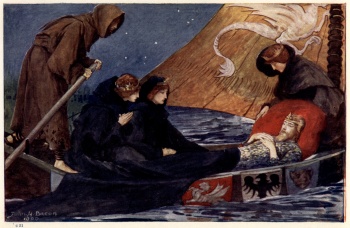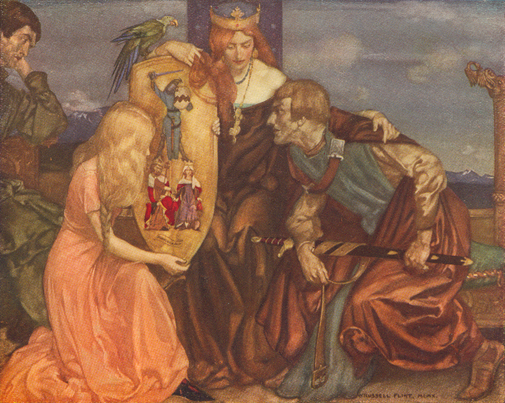
* The Middle Ages
- Read our Overview of the Middle Ages
- Take notes on the following (it's too bad they marred C. S. Lewis' quote; just read "War was" instead of "Was was").
- Major ideas in bold and italics
- Major wars
- Courtly Love
- Characteristics of the Middle Ages
- The Great Happenings



* Arthurian Legend
- The King returns!
- Before you read our story, I want you to get a broader feel for Arthurian legend. To do so, you will explore The Camelot Project at the University of Rochester. You may work together comparing notes, if you wish.
- Read and note at least five important ideas or facts concerning Arthur, Guinevere, the Fisher King, Gawain (for more info. on the Gawain text, go here), and any two of your choice.
- Read and note at least one sentence for each of the six themes and motifs.
- Read and note at least one sentence of notes on Avalon, Camelot, and two other places of your choice.
* And the tale begins!
- It is time to read our glorious tale, Sir Gawain and the Green Knight.
- Please see the .pdf files in the course Google Drive.
- Audio Version from Marie Boroff
- Other Editions
- Here is the same edition online.
- Here is a copy in Middle English.
- I think you will find the prose edition above the best to read and easiest to follow; however, I would like you to read at least the opening 100 lines in verse as well (so read the opening twice). Here is a verse edition at Harvard. The verse edition is closer to the original but harder for a modern student to follow. If you like this better, please read the prose translation first, then read the verse translation.
Introductory Notes
- Encyclopedia Britannica:
- "Sir Gawayne and the Grene Knight, also spelled Sir Gawain And The Green Knight: Middle English alliterative poem of unknown authorship, dating from the second half of the 14th century (perhaps 1375). It is a chivalric romance that tells a tale of enchantment in an Arthurian setting....The poem is technically brilliant. Its alliterative lines (some 2,500) are broken up into irregular stanzas by short rhyming passages; they are tautly constructed, and the vocabulary is astonishingly rich—influenced by French in the scenes at court but strengthened by many dialect words, often of Scandinavian origin, that belonged to northwest England. The blend of sophisticated atmosphere, psychological depth, and vivid language produces an effect superior to that found in any other work of the time."
- Excellent textual notes from a University course
- Note elements of the story you find interesting. What is the style like? How does the author describe things?
- Identify potential symbols in the story. What makes you think this (item, color, location, character, etc.) is symbolic? What might it symbolize? If you have found nothing symbolic by the end of the poem, you should do some rereading.
- Since numerology had an enormous impact on and in medieval and Renaissance works, take note of any numerological elements (also, check out the link here to help you make sense of numerological meanings in the poem). You won't find a great deal here...but the subtle reader will find a few instances.
- Note juxtapositions you encounter in the narrative and consider their dramatic effect.
- How do Beowulf and Gawain compare, both as heroes and as examples of the heroic narrative?
- What is effects does the bob and wheel have on this chivalric romance?
- Which AP Open Essay Prompts would work well with this narrative?
- medieval romance
- symbol
- juxtaposition (and mirror passage)
- Feudalism
- What is feudalism (one sentence)?
- How did feudalism affect unified governance?
- How did feudalism affect trade and economic growth?
- What are the thee estates of the feudal world?
- Chivalry
- What is chivalry?
- What impetus brought it about?
- What are three key components of the chivalrous code?
- Courtly Love
- Why did the courtly lover exist?
- What was the mortal sin?
- Where did the genre begin?
- Where else have you read of elevated romantic passion?

| Two Knights Find the Holy Grail. In some accounts, this is Perceval, others Galahad, others those two and Sir Bors, etc. |
Resources:
- Geographical Introduction #1: Danny Macaskill's "The Ridge"
- BBC Documentary
- Green: The History of a Color (there's something funky about an assumption in here, though)
- Celtic Music
Prompt:
#1 Although Beowulf (somewhere between the 5th and 7th centuries) and King Arthur (late 4th-early 5th century) lived in nearly contemporaneous centuries, their lifestyle, heroic expectations, and poetic composition evince significant differences that reflect the Anglo-Saxon (Old English) to Medieval (or Middle Ages) changes. Explore this idea using specific examples from both poems to support your assertions.
Format:
- Pen
- Single space
- Write on the front of each paper
- Plan for 2-4 minutes before your write the essay
- Don't forget your thesis (first sentence or last sentence of first paragraph)
 |
Launcelot Slays The Caitiff Knight Sir Tarquin Art Print by Frank Cadogan Cowper |
 |
"The Damsel Of The Lake, Called Nimue The Enchantress," 1924 by Frank Cadogan Cowper |


No comments:
Post a Comment